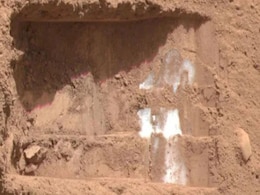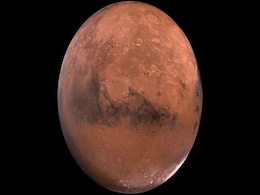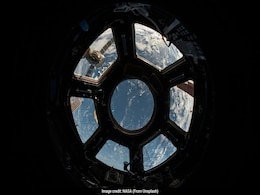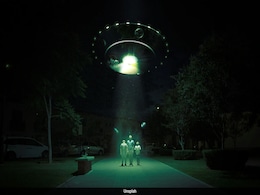Mars Study
- All
- News
- Videos
-

NASA’s Perseverance May Have Found Its First Meteorite on Mars
- Wednesday November 26, 2025
- Written by Gadgets 360 Staff
NASA’s Perseverance rover may have discovered its first meteorite on Mars, a 31-inch iron-nickel boulder named Phippsaksla found in Jezero Crater. Its pitted, coral-like texture and unusually high metal content resemble meteorites previously identified by Curiosity, Spirit, and Opportunity. Scientists are now analysing the rock’s composition in...
-
 www.gadgets360.com
www.gadgets360.com
-

NASA Shares Highly-Anticipated Images Of 3I/ATLAS, Reveals Details Of Mysterious Interstellar Comet
- Thursday November 20, 2025
- Science | Edited by Srishti Singh Sisodia
3I/ATLAS offers a rare chance to study material that has travelled billions of kilometres because it originates from another star system.
-
 www.ndtv.com
www.ndtv.com
-

AI-Assisted Study Finds No Evidence of Liquid Water in Mars’ Seasonal Dark Streaks
- Friday November 14, 2025
- Written by Gadgets 360 Staff
A large-scale AI analysis of more than two million Mars orbiter images shows that the planet’s dark slope streaks form through seasonal dust avalanches, not flowing briny water. The results settle a long-running debate, revealing that wind-driven dust activity shapes Mars’ surface and offering new insights into the planet’s climate past and e...
-
 www.gadgets360.com
www.gadgets360.com
-

Blue Origin Joins SpaceX in Orbital Booster Reuse Era With New Glenn’s Successful Launch and Landing
- Friday November 14, 2025
- Written by Gadgets 360 Staff
Blue Origin’s New Glenn successfully launched NASA’s ESCAPADE mission to Mars on November 13, 2025, marking its second flight and its first ocean booster landing on the ship Jacklyn. The mission deploys twin satellites built by Rocket Lab to study how the solar wind strips Mars’ atmosphere during a 22-month journey to the Red Planet.
-
 www.gadgets360.com
www.gadgets360.com
-

Blue Origin Delays NASA Mars Launch Amid Weather and FAA Restrictions
- Monday November 17, 2025
- Written by Gadgets 360 Staff
Blue Origin has postponed the launch of NASA’s twin ESCAPADE Mars probes due to bad weather and new FAA restrictions on daytime launches during the U.S. government shutdown. The mission, now targeting Nov. 12, will study how solar wind stripped away Mars’s atmosphere. Blue Origin is seeking an FAA exemption to proceed with the launch.
-
 www.gadgets360.com
www.gadgets360.com
-

NASA’s ESCAPADE Mission Will Send Twin Probes to Uncover Mars’s Atmospheric Secrets
- Monday November 10, 2025
- Written by Gadgets 360 Staff
NASA’s ESCAPADE mission will launch twin mini-satellites, Blue and Gold, to Mars aboard Blue Origin’s New Glenn. The probes will study how solar wind stripped away Mars’s atmosphere and water, helping scientists understand the Red Planet’s lost climate and its transformation into the dry world we see today.
-
 www.gadgets360.com
www.gadgets360.com
-

Bad Weather Delays Blue Origin’s New Glenn Launch of NASA’s Mars Mission
- Monday November 10, 2025
- Written by Gadgets 360 Staff
Blue Origin’s New Glenn launch was postponed on November 9, 2025, because of heavy clouds at Cape Canaveral. The rocket was carrying NASA’s twin ESCAPADE orbiters to study Mars’s atmosphere. The delay came a day before the FAA’s new daytime launch ban during a federal shutdown. The next attempt is scheduled for November 12.
-
 www.gadgets360.com
www.gadgets360.com
-

ESCAPADE Mission: NASA To Send Twin Orbiters To Decode Mars' Magnetic Mysteries
- Wednesday November 5, 2025
- Science | Edited by Ritu Singh
The mission is scheduled to launch on November 9, aboard Blue Origin's New Glenn rocket from Cape Canaveral Space Force Station in Florida.
-
 www.ndtv.com
www.ndtv.com
-

NASA Experiment Shows Martian Ice Could Preserve Signs of Ancient Life
- Monday October 20, 2025
- Written by Gadgets 360 Staff
A NASA study suggests that traces of ancient life could be locked in Martian ice. Lab tests freezing bacteria under Mars-like radiation revealed amino acids can persist for tens of millions of years. Researchers say pure ice offers protection, making Mars’ frozen regions ideal for searching preserved biomolecules.
-
 www.gadgets360.com
www.gadgets360.com
-

Exploding Dry Ice May Explain Mars’ Puzzling Dune Patterns, Study Finds
- Friday October 17, 2025
- Written by Gadgets 360 Staff
Scientists recreated Martian gullies in a lab and found they were carved by exploding CO₂ ice blocks, not flowing water. The discovery explains how these trenches form naturally and offers new insight into Mars’ ever-changing landscape
-
 www.gadgets360.com
www.gadgets360.com
-

Microbes Vital For Human Health Show Resilience In Spaceflight, Study Finds
- Sunday October 12, 2025
- Science | Edited by Srishti Singh Sisodia
The bacteria spores can survive rapid acceleration, short-duration microgravity and rapid deceleration.
-
 www.ndtv.com
www.ndtv.com
-

Aliens Could Be Listening To Us Right Now, Says NASA Study
- Saturday September 20, 2025
- Science | Edited by Nikhil Pandey
A new NASA-backed study suggests alien civilisations could eavesdrop on Earth's space transmissions, offering a new approach to detecting extraterrestrial life.
-
 www.ndtv.com
www.ndtv.com
-

Study Links Microbial Colonization to Ancient Meteorite Crater: What You Need to Know
- Sunday September 21, 2025
- Written by Gadgets 360 Staff
A Swedish team has precisely dated microbial life in Finland’s Lappajärvi crater. Isotopic traces show bacteria colonized the hydrothermal system just a few million years after the meteorite impact, thriving for millions of years. The finding suggests impact craters on Earth and Mars may provide lasting habitats for life.
-
 www.gadgets360.com
www.gadgets360.com
-

NASA’s Artemis II Astronauts Will Double as Test Subjects for Deep Space Health Research
- Saturday September 13, 2025
- Written by Gadgets 360 Staff
NASA’s Artemis II mission will send astronauts beyond low Earth orbit as both scientists and volunteer test subjects. The crew will conduct health, radiation, and lunar studies, providing vital data to protect future explorers. Results will guide safety protocols for lunar and Mars missions, advancing human readiness for long-duration deep space ...
-
 www.gadgets360.com
www.gadgets360.com
-

NASA's Hubble Captures Interstellar Comet 3I/ATLAS Ahead of Close Mars Flyby
- Thursday September 4, 2025
- Written by Gadgets 360 Staff
On October 3, 2025, interstellar comet 3I/ATLAS will pass just 30 million km from Mars — nine times closer than from Earth. ESA’s Mars Express and TGO, along with NASA and China’s orbiters, will attempt to image its coma, analyze gases, and study this rare visitor from beyond the solar system.
-
 www.gadgets360.com
www.gadgets360.com
-

NASA’s Perseverance May Have Found Its First Meteorite on Mars
- Wednesday November 26, 2025
- Written by Gadgets 360 Staff
NASA’s Perseverance rover may have discovered its first meteorite on Mars, a 31-inch iron-nickel boulder named Phippsaksla found in Jezero Crater. Its pitted, coral-like texture and unusually high metal content resemble meteorites previously identified by Curiosity, Spirit, and Opportunity. Scientists are now analysing the rock’s composition in...
-
 www.gadgets360.com
www.gadgets360.com
-

NASA Shares Highly-Anticipated Images Of 3I/ATLAS, Reveals Details Of Mysterious Interstellar Comet
- Thursday November 20, 2025
- Science | Edited by Srishti Singh Sisodia
3I/ATLAS offers a rare chance to study material that has travelled billions of kilometres because it originates from another star system.
-
 www.ndtv.com
www.ndtv.com
-

AI-Assisted Study Finds No Evidence of Liquid Water in Mars’ Seasonal Dark Streaks
- Friday November 14, 2025
- Written by Gadgets 360 Staff
A large-scale AI analysis of more than two million Mars orbiter images shows that the planet’s dark slope streaks form through seasonal dust avalanches, not flowing briny water. The results settle a long-running debate, revealing that wind-driven dust activity shapes Mars’ surface and offering new insights into the planet’s climate past and e...
-
 www.gadgets360.com
www.gadgets360.com
-

Blue Origin Joins SpaceX in Orbital Booster Reuse Era With New Glenn’s Successful Launch and Landing
- Friday November 14, 2025
- Written by Gadgets 360 Staff
Blue Origin’s New Glenn successfully launched NASA’s ESCAPADE mission to Mars on November 13, 2025, marking its second flight and its first ocean booster landing on the ship Jacklyn. The mission deploys twin satellites built by Rocket Lab to study how the solar wind strips Mars’ atmosphere during a 22-month journey to the Red Planet.
-
 www.gadgets360.com
www.gadgets360.com
-

Blue Origin Delays NASA Mars Launch Amid Weather and FAA Restrictions
- Monday November 17, 2025
- Written by Gadgets 360 Staff
Blue Origin has postponed the launch of NASA’s twin ESCAPADE Mars probes due to bad weather and new FAA restrictions on daytime launches during the U.S. government shutdown. The mission, now targeting Nov. 12, will study how solar wind stripped away Mars’s atmosphere. Blue Origin is seeking an FAA exemption to proceed with the launch.
-
 www.gadgets360.com
www.gadgets360.com
-

NASA’s ESCAPADE Mission Will Send Twin Probes to Uncover Mars’s Atmospheric Secrets
- Monday November 10, 2025
- Written by Gadgets 360 Staff
NASA’s ESCAPADE mission will launch twin mini-satellites, Blue and Gold, to Mars aboard Blue Origin’s New Glenn. The probes will study how solar wind stripped away Mars’s atmosphere and water, helping scientists understand the Red Planet’s lost climate and its transformation into the dry world we see today.
-
 www.gadgets360.com
www.gadgets360.com
-

Bad Weather Delays Blue Origin’s New Glenn Launch of NASA’s Mars Mission
- Monday November 10, 2025
- Written by Gadgets 360 Staff
Blue Origin’s New Glenn launch was postponed on November 9, 2025, because of heavy clouds at Cape Canaveral. The rocket was carrying NASA’s twin ESCAPADE orbiters to study Mars’s atmosphere. The delay came a day before the FAA’s new daytime launch ban during a federal shutdown. The next attempt is scheduled for November 12.
-
 www.gadgets360.com
www.gadgets360.com
-

ESCAPADE Mission: NASA To Send Twin Orbiters To Decode Mars' Magnetic Mysteries
- Wednesday November 5, 2025
- Science | Edited by Ritu Singh
The mission is scheduled to launch on November 9, aboard Blue Origin's New Glenn rocket from Cape Canaveral Space Force Station in Florida.
-
 www.ndtv.com
www.ndtv.com
-

NASA Experiment Shows Martian Ice Could Preserve Signs of Ancient Life
- Monday October 20, 2025
- Written by Gadgets 360 Staff
A NASA study suggests that traces of ancient life could be locked in Martian ice. Lab tests freezing bacteria under Mars-like radiation revealed amino acids can persist for tens of millions of years. Researchers say pure ice offers protection, making Mars’ frozen regions ideal for searching preserved biomolecules.
-
 www.gadgets360.com
www.gadgets360.com
-

Exploding Dry Ice May Explain Mars’ Puzzling Dune Patterns, Study Finds
- Friday October 17, 2025
- Written by Gadgets 360 Staff
Scientists recreated Martian gullies in a lab and found they were carved by exploding CO₂ ice blocks, not flowing water. The discovery explains how these trenches form naturally and offers new insight into Mars’ ever-changing landscape
-
 www.gadgets360.com
www.gadgets360.com
-

Microbes Vital For Human Health Show Resilience In Spaceflight, Study Finds
- Sunday October 12, 2025
- Science | Edited by Srishti Singh Sisodia
The bacteria spores can survive rapid acceleration, short-duration microgravity and rapid deceleration.
-
 www.ndtv.com
www.ndtv.com
-

Aliens Could Be Listening To Us Right Now, Says NASA Study
- Saturday September 20, 2025
- Science | Edited by Nikhil Pandey
A new NASA-backed study suggests alien civilisations could eavesdrop on Earth's space transmissions, offering a new approach to detecting extraterrestrial life.
-
 www.ndtv.com
www.ndtv.com
-

Study Links Microbial Colonization to Ancient Meteorite Crater: What You Need to Know
- Sunday September 21, 2025
- Written by Gadgets 360 Staff
A Swedish team has precisely dated microbial life in Finland’s Lappajärvi crater. Isotopic traces show bacteria colonized the hydrothermal system just a few million years after the meteorite impact, thriving for millions of years. The finding suggests impact craters on Earth and Mars may provide lasting habitats for life.
-
 www.gadgets360.com
www.gadgets360.com
-

NASA’s Artemis II Astronauts Will Double as Test Subjects for Deep Space Health Research
- Saturday September 13, 2025
- Written by Gadgets 360 Staff
NASA’s Artemis II mission will send astronauts beyond low Earth orbit as both scientists and volunteer test subjects. The crew will conduct health, radiation, and lunar studies, providing vital data to protect future explorers. Results will guide safety protocols for lunar and Mars missions, advancing human readiness for long-duration deep space ...
-
 www.gadgets360.com
www.gadgets360.com
-

NASA's Hubble Captures Interstellar Comet 3I/ATLAS Ahead of Close Mars Flyby
- Thursday September 4, 2025
- Written by Gadgets 360 Staff
On October 3, 2025, interstellar comet 3I/ATLAS will pass just 30 million km from Mars — nine times closer than from Earth. ESA’s Mars Express and TGO, along with NASA and China’s orbiters, will attempt to image its coma, analyze gases, and study this rare visitor from beyond the solar system.
-
 www.gadgets360.com
www.gadgets360.com
























